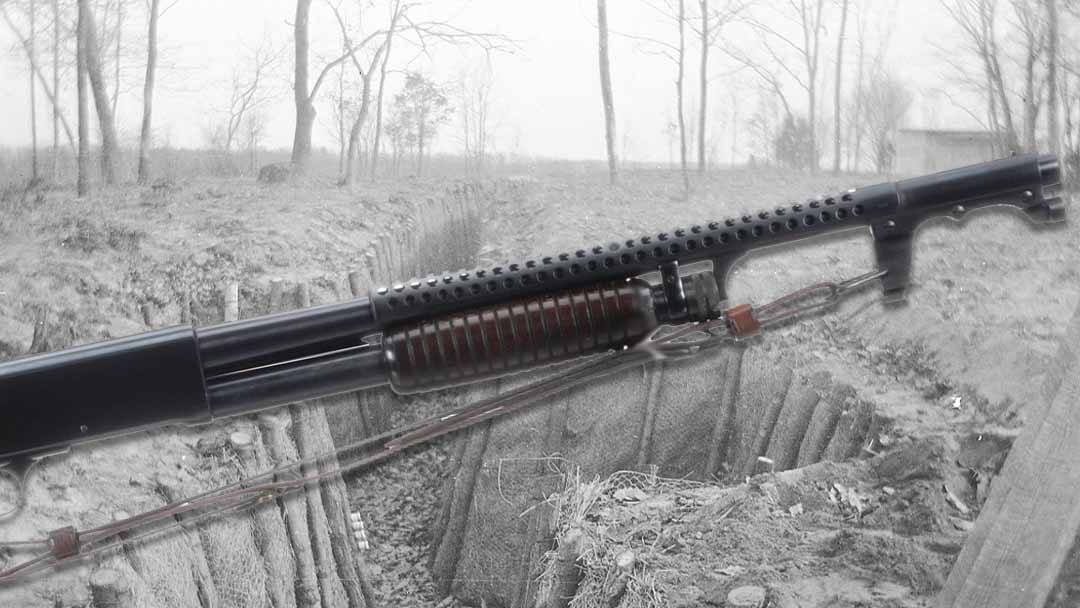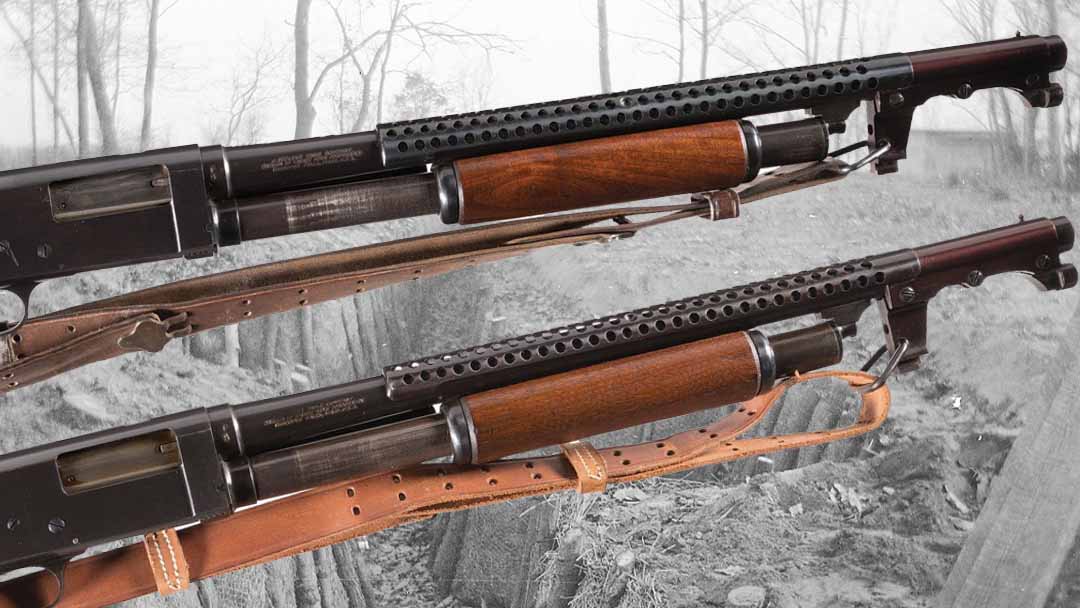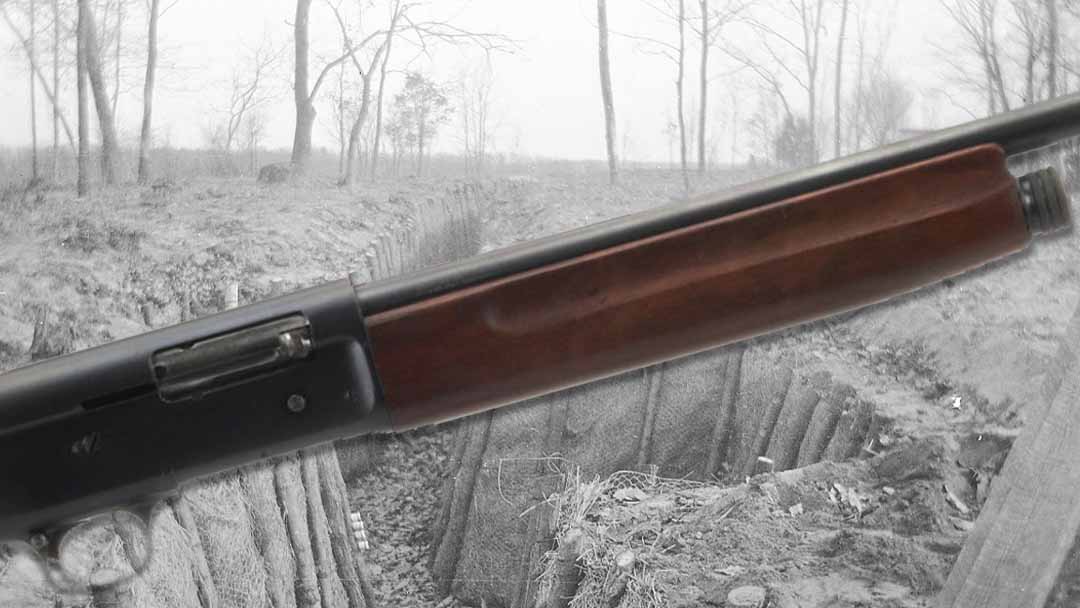U.S. soldiers attempting to quell the 1900 Philippines uprising often found their weapons ineffective against the ferocious suicide attacks by Moro swordsmen.
Capt. John Pershing saw one weapon stand out during this close quarters fighting — the Winchester Model 1897 shotgun. While soldiers returned to using .45 Colt revolvers with more stopping power than their .38 Colts, the close quarter fighting also served as the spark for the M1911 in .45 ACP.
As the United States prepared to join the fight in World War I, Pershing, now a general and head of the American Expeditionary Forces, recalled the Winchester’s effectiveness in the Philippines and envisioned how they could be wielded in the trenches of the French battlefields. He asked the Ordnance Department to request modifications.

The popular civilian model Winchesters, invented by John Moses Browning, had 20-inch barrels, a sling swivel, bayonet adapter, and perforated metal heat shield over the 12-gauge barrel. The trench gun was born.
The weapons got good reviews from the troops.
“Shotguns in this regiment have given very satisfactory results. Their effectiveness at short ranges, on raids and patrols makes them a most desirable weapon, and I would recommend that they be adopted,” wrote one unit commander.
Along with the Model 1897, Winchester’s hammerless Model 1912, plus Remington’s M10, and M11 were modified for action in the trenches. About 25,000 Winchesters and 3,500 Remingtons were delivered during World War I. The United States was the only major power to use shotguns during the war.
Shotgun shells were also modified for use on the front lines. The shells went from paper tubes to all brass cartridges because of wet conditions along the battlefront. If the cardboard tubes got wet they would swell and jam the gun or became unusable before they went into the gun.

Eight trench shotguns of various manufacture and eight of their police brethren, the riot shotgun, are available in Rock Island Auction Company’s June 22-24 Sporting and Collector Auction.
Germans Protest Trench Gun
The shorter barrel made the guns easier to maneuver in the narrow trenches. The U.S. Army used double-aught buckshot that blasts out nine .33 caliber pellets. Slam firing (we’ll get to that shortly) could clear a trench in ferocious close-in fighting, earning the shotgun the nickname “trench sweeper” or “trench broom.” Gen. John T. Thompson coined the nickname for his Tommy gun though it never saw use in World War I.
One report offered a glimpse at lethality of the trench guns: “[H]is men had one good chance with them (shotguns) at a German mass assault upon his trench—a charge obviously intended to overwhelm the defenders with its solid rush of men. (They) let them come on; and when those shotguns got going—with nine .34 caliber buckshot per load, 6 loads in the gun, 200-odd men firing, plenty more shells at hand—the front ranks of the assault simply piled up on top of one awful heap of buckshot-drilled men.”

In September 1918, the Germans issued a diplomatic protest saying the shotgun caused “unnecessary suffering”: “The German Government protests against the use of shotguns by the American Army and call attention to the fact that according to the laws of war (Kriegsrecht), every U.S. prisoner (of war) found to have in his possession such guns or ammunition belonging thereto forfeits his life. This protest is based upon article 23(e) of the Annex of the Hague convention respecting the laws and customs of war on land.”
The United States rejected the protest. In return, Pershing replied that any German caught with a flamethrower or saw-bladed bayonet would be lined up and shot.
There were no reports of either side committing such executions, but the military did censor photos of doughboys with shotguns.
Slam Fire
Trench guns don’t have a trigger disconnector, allowing them to be slam fired. Slam firing is pulling the trigger and holding it while working the shotgun’s pump action, repeatedly firing, ejecting a spent shell and chambering a new shell. A trained soldier could empty the shotgun of its six shells with devastating effect in less than two seconds.

The military required heat shields on trench guns because the barrel could become quite hot after firing only a few shells and if hand-to-hand combat was expected, soldiers had to be able to grab the gun to fight with a bayonet.
The shotguns available at auction that slam fire include Winchester Model 1897 and Model 12, the Stevens 620 and 520-30, the Ithaca Model 37, and Remington Model 10A.
Tall Tale or True?
Two stories follow the World War I trench shotgun. One is the story of Sgt. Fred Lloyd and the second involves skeet shooting.
According to legend, Sgt. Lloyd single-handedly cleared a German-held French village with his Winchester 97 on Sept. 27, 1918. He moved methodically through the never-named village, pumping round after round from his shotgun, routing 30 German soldiers until he collapsed with exhaustion. Thought the date is always the same and the tale is always worded similarly, it appears to be one of the myths of war.
The second legend goes that skilled skeet shooters were issued trench guns and stationed to watch for flying grenades to shoot from the sky. While it was certainly possible, it wasn’t likely, and at night was truly impossible.

Combat Shotguns
Shotguns were useful in the trenches of World War I, but found less action on the more wide open European battlefields of World War II. They did have their use in the Pacific theater, clearing Japanese bunkers and earthen fortifications.
In Vietnam, Winchester’s Model 12 and the Stevens M520-30 were still in use. The military also contracted with Ithaca for its Model 37 with a Parkerized finish to protect the gun metal. Parkerizing is a method of applying a chemical phosphate that creates a thin adhering layer of iron, zinc, or manganese phosphates over the steel. In Vietnam, shotguns were mostly used for night ambushes and perimeter defense.
By that time, shotgun cartridges were no longer all-brass. They were made of plastic that was water resistant and durable. Also, they contained smaller shot, with No. 4 buckshot.
U.S. Air Force security police carried Winchester Model 1200 or Remington 870 shotguns for base security during Operations Desert Shield and Desert Storm.
Shotguns remain in the American military arsenal as part of potential military response might that might be needed in urban areas or boarding a ship where short-barreled shotguns are more maneuverable and can spray confined spaces.
Special forces units, like the U.S. Army’s Delta Force operatives carry cut-down pump shotguns loaded with solid slugs used to neutralize door locks. This Lightweight Shotgun System (LSS) is fitted underneath the barrel of an M16 and added only 2 lbs., 11 oz. of weight.

Riot Shotguns
On the homefront, police found a use for the short-barreled shotguns after World War I. They could be mounted in cars and served as “the great intimidator.” Police used shotguns may not have a heat shield.
The Philadelphia Police embraced the riot shotgun just as the department began using motorcycles for rapid response. Shotgun wielding officers rode in sidecars.
For decades, shotguns were part of an officer’s gear until the North Hollywood shootout in 1997 when police came up against heavily armed men wearing body armor. Shotguns were no match. That began the call to arm officers with AR15s that have become more standard in policing.

Trench Guns
Trench guns have a larger-than-life reputation for their slam fire heroics in World War I, be they Winchester or Remington. The military continued to use short barrel shotguns made by Stevens and Ithaca as they island-hopped across the Pacific. They found a home domestically with police for several decades.
Check out the numerous selections of trench shotguns and riot shotguns in Rock Island Auction Company’s June 22-24 Sporting and Collectors Auction, the perfect gun gift for dad this Father’s Day.
Sources:
The “Trench Gun” in World War I, by Bruce N. Canfield
“Bruce N. Canfield’s Complete Guide to United States Military Combat Shotguns”
“The Trench Shotguns of World War I Were Uniquely American,” by Steve Balestrieri